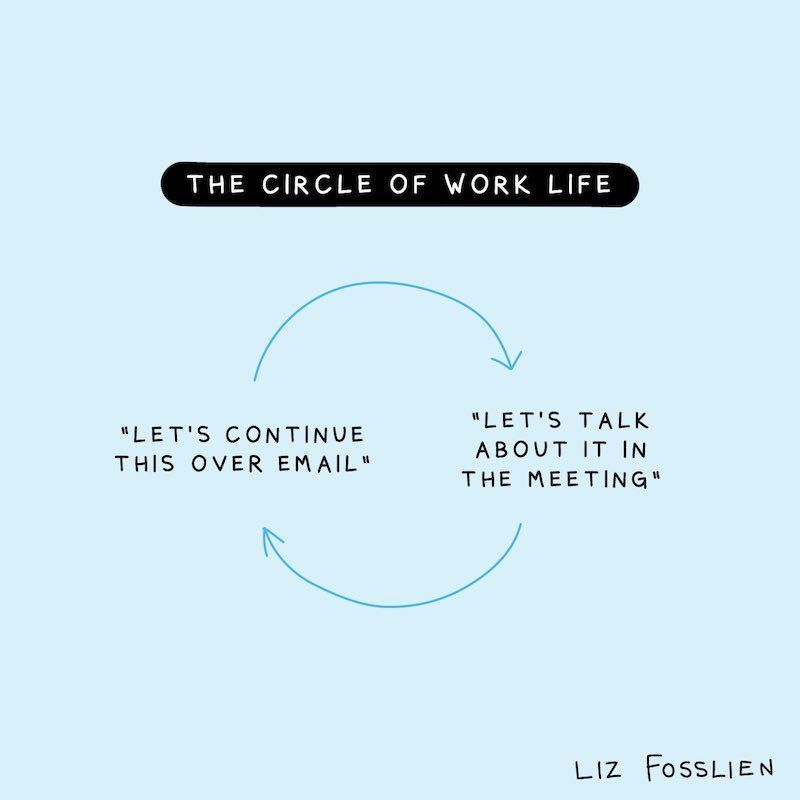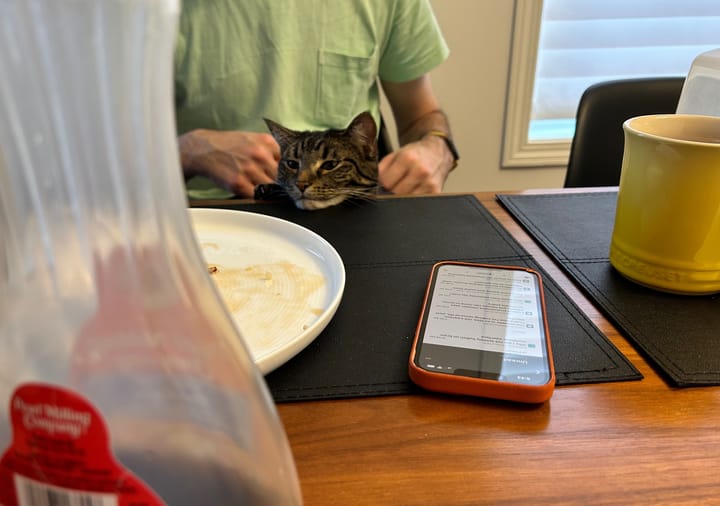How to Have More Effective Meetings - Part 1: Purpose and People
First things first, for your meetings to be effective you need to know why you are meeting and who needs to be there!

There are many scenes from Meetings, Bloody Meetings, a 1976 British comedy written and starred in by Monty Python’s John Cleese, that portray the pitfalls that corporate meeting cultures fall prey to.
Two of my favourites are:
No one in the meeting knows who’s responsible for what.
and
John Cleese’s character tells his wife he can’t work at work and has to work at home because he’s in meetings all the time.
While meant to be parodies, they cut sadly close to the reality of many people’s meeting experiences today (even 47 years later). So many meetings are a complete waste!
To back it up even further, here are some interesting (and horrifying) stats about time spent in meetings[1]:
- The average worker spends at least 3 hours a week in meetings, with 30% of workers reporting that they spend over 5 hours per week in meetings.
- Organizations spend roughly 15% of their time on meetings, with surveys showing that 71% of those meetings are considered unproductive.
- An estimated $37 billion is lost per year to unproductive meetings.
- Workers spend an average of 31 hours per month in unproductive meetings.
😬 That’s a lot of time and money.
So what can be done to make your meetings “good”?
What makes a meeting “good” or “bad”
First off let’s get some clarity on what constitutes a good meeting versus a bad meeting.
A bad meeting is when:
- You don’t know why the meeting was called in the first place (no agenda).
- No one is prepared and you spend half the meeting learning what it’s about.
- The meeting is a one-way lecture or update that could have been an email
- The meeting has too many people so the conversation is shallow and not everyone can contribute.
- Nothing is written down so there is no record of decisions or action items.
- The meeting has too many priorities and is too long.
- There is no accountability.
- You leave feeling frustrated and/or exhausted.
Do any of those things sound familiar?
In contrast, a good meeting is when:
- The purpose of the meeting is clear.
- Everyone who attended the meeting was prepared.
- Everyone who attended the meeting should be there.
- You got to the outcome you were working towards or opened up new options.
- The actions and the people responsible for taking them following the meeting are clear.
- People are being held accountable for the actions they agreed to take.
- You feel like the time was well spent and efficient.
- You leave feeling like you have resolved something, come to a decision, or the path forward is clear.
- You feel like you positively contributed and were heard.
That sounds awesome, right? So what’s the problem? Turns out there are several pieces that need to come together to make a meeting good (or even great!). I’ve broken those pieces out into the 4Ps of meetings:
- Purpose: Why are you meeting?
- People: Who should be in the room?
- Process: How is the meeting run?
- Product: What did you produce/what’s next?
In this article, I cover Purpose and People, with Process and Product coming up next.
1. Purpose: Why are you meeting?
The very first thing you need to establish is if you should meet in the first place. Psychologist Adam Grant posits that there are 4 main reasons for meeting: decide, learn, bond, and do.
1. Decide: Strategy, problem-solving
Many meetings are called when a decision needs to be made and input from others is required. They are meant to move something forward by collecting input and then setting a path forward. This includes things like a strategic planning meeting where you want to decide on the priorities for next quarter or a discussion about a tricky programming challenge with several implementation options.
2. Learn: Performance reviews, project reflection, coaching
Meetings that are focused on learning include things like performance reviews, project post-mortems and coaching. These are meetings where you reflect back to learn what you could improve on for the future or learn new skills.
3. Do/Create: Brainstorming
Some things benefit from having several smart people in the room to collaborate, generate ideas or to co-work on a tedious task so these are meetings that focus on doing or creating something as a group, like brainstorming.
4. Bond: Team building
The final reason to meet is to bond as a team and build relationships. Bonding is often not the only reason you meet but is a valuable by-product of a well-run meeting where people are given time to interact, share ideas, and be heard.
Most meetings are some combination of these reasons!
What about updates?
You will notice that nowhere in the reasons for meeting did I include giving an update.
Updates are a one-way delivery of information and can often be sent either as an email, chat message, or attachment to be read prior to the meeting. Instead of wasting time giving an update in the meeting, let people review updates on their own. If there is a problem that needs to be discussed once an update has been provided, it can be included separately.
How do you know if you should cancel a meeting or go forward with it?
Start with the outcome!
When you decide to host a meeting, you need to have clarity on what you want to achieve. One of the ways you can do this is to imagine that the meeting is done and it was awesome. Ask yourself:
What happened in the meeting that made it awesome?
Then you can figure out what you need to do to make it happen:
- What information do you need to provide ahead of the meeting?
- When does it need to be sent to give people enough time to prepare?
- Who should be there?
- Who is best suited to help with deciding, bonding, learning or creating?
If you are not clear on the outcome you want, you are not ready to meet or don’t need to meet at all.
The double-edged sword of recurring meetings
Recurring meetings are great because they keep time aside in your calendar, set an expectation and a rhythm, and are good opportunities for regular connection with your team or clients. However, they sometimes can become like a bad habit where you just go through the motions of the meeting instead of being thoughtful about your purpose.
To help make sure your recurring meetings are still a good use of everyone's time you can:
- Prepare an agenda ahead of each recurring meeting to determine
- If it should go ahead;
- Be skipped entirely;
- Or an email update sent out instead.
Schedule a quarterly review of all recurring meetings to establish:
- What’s the purpose?
- Is this meeting still necessary?
- Are the right people in the room still?
Remember, just because it’s on the calendar, doesn’t mean it has to happen!

2. People: Who should be in the room?
Another common challenge in meetings is having too many people in the room, the wrong people in the room, or both. There is often an instinct to blanket invite people to meetings to make them feel included or make sure they are kept up to speed on the topics being discussed.
The problem with a blanket-invite approach is that it doesn’t consider the opportunity cost of meetings.
The opportunity cost of meetings
Not all meetings are created equal and there is an opportunity cost to the time spent in the meeting, including the time taken to travel if it is in person and/or the dead time between meetings. The opportunity cost is all the other things you could do instead.
The questions to ask yourself every time you are asked to attend a meeting are:
- What could I do with that time instead of going to a meeting?
- Is the meeting more valuable than those other things?
- If I accept this meeting, how does it impact the rest of my day and week?
And if you are asking someone else to attend a meeting, especially if you are their manager or leader, the question is:
What could they do with that time instead?
Saying yes to the meeting may still be the best use of your time, but it’s always worth taking a moment to consider the opportunity cost.
How many people should be in a meeting?
According to research out of Stanford University, the most productive meetings have "seven, plus or minus two." The idea is the more people you add to your meeting, the less effective a meeting will be because:
- It’s harder to have inclusive discussions
- It’s harder to keep people engaged
- People become more guarded and less candid
- Tough topics and decisions are not put on the agenda, then are dealt with at another time instead
So you want to aim for somewhere between five to nine people and try to err on the side of “less is more”.
The 4 meeting roles
Once you have figured out who you want in the meeting, you can then establish and assign meeting roles. Within each meeting, there are 4 potential roles, each with its own responsibilities:
- Chair: The chair is the person who called the meeting. They need to create an agenda, send it out ahead of the meeting, and guide the conversation during the meeting. They set the tone and outcomes.
- Minute’s taker: The minute's taker takes meeting minutes! They record relevant discussion points, and action items, and note the person responsible and when the action item is due. They also send out the meeting minutes when the meeting is over.
- Time/topic keeper: The time and topic keeper keeps an eye on the time, notifies the chair when a discussion is going long and will jump in if the discussion gets off-topic. This is usually a role done either by the chair themselves or the minute taker.
- Attendee: An attendee is a person who was invited to the meeting. They are responsible for preparing ahead of the meeting and being engaged and actively participating during the meeting.
Every meeting has an individual chair and attendee(s). The minute taker and time/topic keeper roles may be done by the chair, attendee, or as individual roles on their own.
Coming up next
Having effective meetings is possible! It just takes a bit more thought and effort than throwing a bunch of people in a room and seeing what happens. In this article, I covered the first of the 4Ps of meetings: Purpose and People, emphasizing the importance of having clarity on the outcome you want to achieve, as well as making sure you have the right people in the room.
In my next article, I will cover Process and Product!
Want to have more effective meetings in your organization? I teach this as a learning session! Reach out to chat about having me speak to your team.
Share
Ashley Janssen

Productivity consultant, writer, speaker, serial entrepreneur, chaos calmer, introvert, cat-lady. Lover of books, fitness, old fashioned’s, basketball, and video games.
Follow me on
Twitter
or
LinkedIn.
Hire me for
1 on 1 productivity consulting
or
speaking.
Related articles

Debunking The False Promises of Productivity

How to Set Yourself Up for Big Conversations


Comments ()